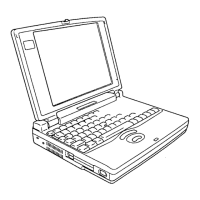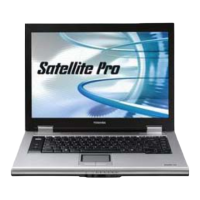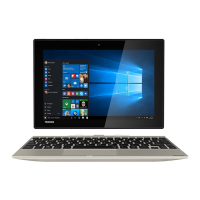
Do you have a question about the Toshiba 1000-S157 and is the answer not in the manual?
| Display | 14.1-inch TFT |
|---|---|
| Battery Life | Up to 3 hours |
| Graphics | Integrated |
| Operating System | Windows XP |
| CPU | Intel Pentium III |
Equipment complies with FCC limits for Class B digital devices, designed for reasonable protection against harmful interference.
Device operates under Part 15 of FCC Rules, subject to two conditions regarding interference.
Identifies ports and features on the back of the computer, including cooling vent and DC-IN jack.
Identifies ports and features on the left side of the computer, including audio jacks.
Describes the front panel with the display open, showing screen, keyboard, and TouchPad.
Details the system indicator lights and their meanings, like power and battery status.
Initial steps for setting up the computer, including battery charging and connecting peripherals.
Procedure for connecting the AC adapter for powering the computer and charging batteries.
Detailed instructions for charging the computer's internal battery.
Steps to turn on the computer and information on indicator lights.
Initial software setup steps, including time zone selection and system registration.
Introduction to the computer's keyboard layout, character keys, and function keys.
Importance of saving work frequently and how to perform the save operation.
Steps for printing documents from applications using the Print dialog box.
Information about different types of CD/DVD drives and their capabilities.
Introduction to playing DVDs using the WinDVD software.
Important safety guidelines for handling, disassembling, and disposing of batteries.
Tips to extend the lifespan and performance of the computer's battery.
How to check the battery's current charge status using the battery light indicator.
How to navigate and use the Windows XP desktop interface, including icons and taskbar.
How to use the TouchPad and control buttons together for screen navigation.
How to launch programs from the Start menu, such as Paint and Windows Explorer.
How to create desktop shortcuts for quick access to programs like Calculator.
How to restore the system to a previous configuration point using System Restore.
How to play DVD movies using the WinDVD software and its control panel.
Explanation of the WinDVD toolbar and its basic playback controls.
Configuring speaker modes and vocal options for DVD playback.
Adjusting aspect ratio, full screen mode, and On Screen Display settings.
Steps to close a program that has frozen or stopped responding using Task Manager.
Troubleshooting steps for issues encountered during the computer's power-on sequence.
Guidance on troubleshooting and resolving hardware conflicts using Device Manager.
Troubleshooting unexpected characters or unresponsive keys on the keyboard.
Troubleshooting issues with hard disk and diskette drives, including errors and slow performance.
Common issues encountered when installing or using PC Cards, including recognition errors.
Troubleshooting common modem issues like failure to receive or transmit data.
Explanation of keys that activate system functions when combined with the Fn key.
Using Fn+F10, F11, F12 for cursor, numeric, and scroll lock overlays.












